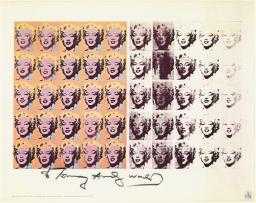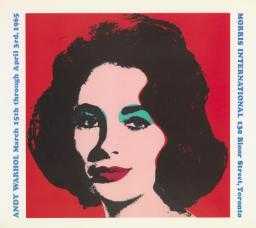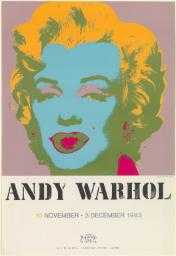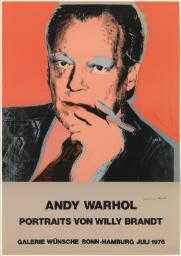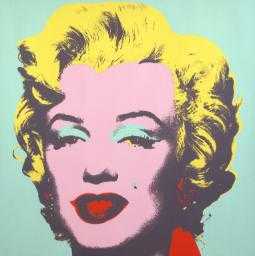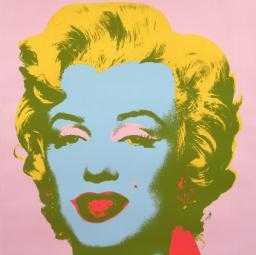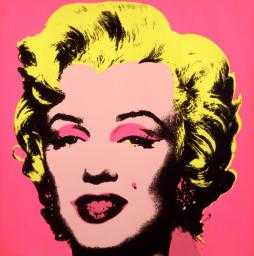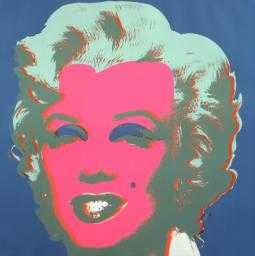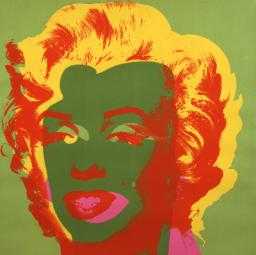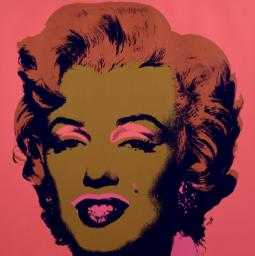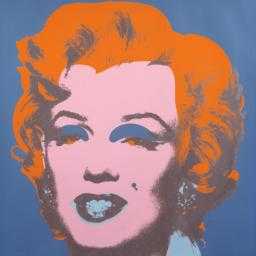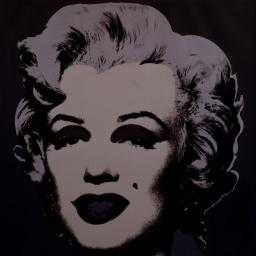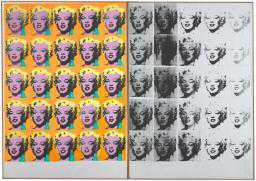
Not on display
- Artist
- Andy Warhol 1928–1987
- Part of
- Marilyn
- Medium
- Screenprint on paper
- Dimensions
- Image: 910 × 910 mm
frame: 932 × 932 × 41 mm - Collection
- Tate
- Acquisition
- Purchased 1971
- Reference
- P07124
Display caption
In Marilyn Monroe, Warhol found a fusion of two of his consistent themes: death and the cult of celebrity. The star died tragically in August 1962. In the following two years, Warhol made thirty silkscreen paintings of her, always using the same publicity photograph from the 1953 film Niagara. This set of ten screenprints was produced in 1967, in an edition of 250. The repeated image serves as the basis for a series of startling colour transformations.
Gallery label, September 2004
Does this text contain inaccurate information or language that you feel we should improve or change? We would like to hear from you.
Catalogue entry
P07121-30 Marilyn 1967
Each print is signed on the back 'Andy Warhol' b.l. and stamped 224/250' b.r.
Ten screenprints on paper, 36 x 36 (91.4 x 91.4)
Purchased from the Leo Castelli Gallery (Grant-in-Aid) 1971
Prov: Factory Additions, New York; with Leo Castelli, New York
Lit: Rainer Crone, Andy Warhol (London 1970), No.619, p.310 (publisher wrongly given as Leo Castelli); Riva Castleman, Modern Prints since 1942 (London 1973), p.134, repr. p.135 in colour
A set of ten screenprints in different colours published by the artist and his assistants under the name Factory Additions, New York, in 1967 in an edition of 250. This set is no.224.
Andy Warhol had previously made twenty-three paintings of Marilyn Monroe in 1962, the year of her death, and a further seven in 1964, all based on the same photograph showing her face turned slightly to her right, with her lips parted in a smile. Many of these contain a series of repetitions of this image in rows one above another (up to as many as fifty in a picture), with slight variations due mainly to the deliberate irregularity of the screen printing. Several only show repeat images of the mouth and omit the rest of the face altogether.
Although some of these pictures contain variations in the colouring and, especially in those of 1964, a tendency to divide the face into distinct colour zones, it was only in this series of screenprints made in 1967 that colour became the dominant feature; the image served as the basis for a series of startling colour transformations.
The principal colours are as follows:
P07121 Background green, hair yellow, face lilac, lips red, eyelids green.The photograph used by Warhol as the basis for all his paintings and prints of Marilyn Monroe was a 20th Century Fox still, publicity for the film Niagara 1953, taken by Gene Kornman [reproduced p.761: not reproduced here]. (Information from John Kobal).
P07122 Background shocking pink, hair peach, face red, lips yellow, eyelids pink.
P07123 Background lilac, hair yellow, face blue, lips green, eyelids lilac.
P07124 Background dull pink and silver, hair oatmeal, face silver, lips shocking pink, eyelids dull pink and silver.
P07125 Background shocking pink, hair yellow, face peach, lips purple, eyelids shocking pink.
P07126 Background turquoise blue, hair green, face shocking pink, lips green, eyelids blue and green.
P07127 Background green, hair yellow, face green, lips terracotta and purple, eyelids green.
P07128 Background dull pink, hair brown, face ochre, lips purple, eyelids dull pink.
P07129 Background blue, hair orange, face lilac, lips silver, eyelids blue.
P07130 Background dark grey, hair light grey, face pale putty, lips black and grey, eyelids dark grey.
Published in:
Ronald Alley, Catalogue of the Tate Gallery's Collection of Modern Art other than Works by British Artists, Tate Gallery and Sotheby Parke-Bernet, London 1981, pp.760-2, reproduced p.760
Explore
- emotions, concepts and ideas(16,416)
-
- formal qualities(12,454)
-
- colour(836)
- photographic(4,673)
- clothing and personal items(5,879)
-
- make-up(87)
- head / face(2,497)
- Monroe, Marilyn(27)
- individuals: female(1,698)
- birth to death(1,472)
- cultural icon(63)
- arts and entertainment(7,210)
-
- actor(261)
You might like
-
Andy Warhol Marilyn Monroe
1962 -
Andy Warhol Liz
1965 -
Andy Warhol Marilyn Monroe
1983 -
Andy Warhol Willy Brandt
1976 -
Andy Warhol [no title]
1967 -
Andy Warhol [no title]
1967 -
Andy Warhol [no title]
1967 -
Andy Warhol [no title]
1967 -
Andy Warhol [no title]
1967 -
Andy Warhol [no title]
1967 -
Andy Warhol [no title]
1967 -
Andy Warhol [no title]
1967 -
Andy Warhol [no title]
1967 -
Andy Warhol [no title]
1972 -
Andy Warhol Marilyn Diptych
1962

